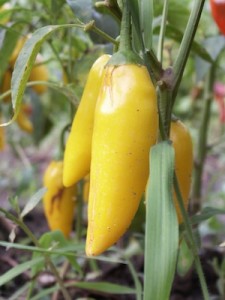 Do you have more peppers in your garden than you know what to do with? Maybe you’re sick of fajitas, stuffed peppers, and stir-fry and you’ve dried enough peppers to season your food for the rest of your life, but you can’t bear to let your peppers go to waste either. So why not pickle them and enjoy them even after the season is over? Not only is pickling a great way to preserve your harvest, but when you ferment your food, you are actually improving nutritional value of that harvest. The process that ferments the food actually adds valuable nutrients to it, providing additional health benefits. And although it may sound intimidating, fermenting your food is actually a very simple process—the hardest part is waiting for your goodies to be ready!
Do you have more peppers in your garden than you know what to do with? Maybe you’re sick of fajitas, stuffed peppers, and stir-fry and you’ve dried enough peppers to season your food for the rest of your life, but you can’t bear to let your peppers go to waste either. So why not pickle them and enjoy them even after the season is over? Not only is pickling a great way to preserve your harvest, but when you ferment your food, you are actually improving nutritional value of that harvest. The process that ferments the food actually adds valuable nutrients to it, providing additional health benefits. And although it may sound intimidating, fermenting your food is actually a very simple process—the hardest part is waiting for your goodies to be ready!
Pickled Peppers
Equipment:
- Wide-mouth quart mason jar
- Smaller jar that can fit inside the mason jar
- Cheesecloth or small towel
- Mixing bowl
Ingredients:
- 4 cups fresh peppers (your choice)
- ½ onion, sliced
- 3 cloves garlic, roughly chopped
- 3 tablespoons pickling salt
- 4 cups water
Before starting, make sure you’ve washed your peppers and that all are in good shape— remember that old or bruised produce will not make good pickles. If you are using large peppers (such as bell peppers), you many need to cut them into smaller pieces to fit into your jar.
- Combine the peppers, onions, and garlic and add them to the mason jar.
- Mix together the water and salt and pour over the vegetables, ensuring that the brine completely covers them.
- Place the small jar inside the larger one to hold the peppers below the brine. Add water to the smaller jar, if necessary, to keep it in place.
- Cover with the cheesecloth or towel and allow to ferment in an out-of-the-way place for about one week before enjoying.
Prepare now for surging food costs and empty grocery store shelves…
Pepper Sauce
Equipment:
- 2 quart-size mason jars
- Several pieces of cheesecloth
- Mixing bowl
- Food processor, if desired
Ingredients:
- 3 pounds fresh chili peppers (your choice) with stems removed
- 5 cloves garlic, peeled and minced
- 2 teaspoons pickling salt
- 4 tablespoons whey (see below for recipe)
- Combine and mince all ingredients until fine and pasty (use a food processor if desired).
- Pour the paste into one of the jars and cover with a piece of cheesecloth. Ferment for five to seven days in an out-of-the-way place.
- After a week, place a large piece of cheesecloth in the mixing bowl and pour the fermented sauce in. Carefully pick up the cheesecloth and squeeze the sauce out, leaving any residue or pieces in the cloth.
- Pour the strained sauce from the bowl into the clean jar and store it in the refrigerator. The sauce will keep for several months.
Making Whey
Plain yogurt is a great source of whey and probably the most accessible for the average person. If you don’t have any of your own homemade yogurt and are in need of whey for a recipe, store-bought yogurt will still get you what you need.
Equipment:
- Colander or sieve
- Bowl that will hold your colander
- Cheesecloth
Ingredients:
- 1/2 cup gelatin-free plain yogurt
- Line the colander or sieve with cheesecloth and place the colander into the bowl.
- Pour the yogurt into the cheesecloth-lined colander. Gather up the edges and squeeze gently. About four tablespoons of whey should drip into the bowl.
These recipes are all featured in Fermentation Factor, available from Solutions from Science. To learn more about the process of fermentation, its benefits, and tasty recipes that can preserve your harvests and your health, check out this great book!
©2012 Off the Grid News
 Off The Grid News Better Ideas For Off The Grid Living
Off The Grid News Better Ideas For Off The Grid Living




